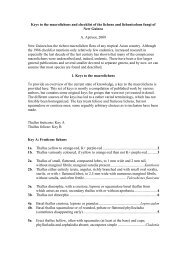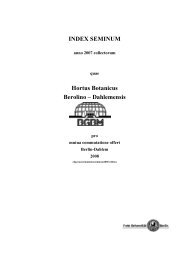DIG35 Specification: Metadata for Digital Images. Version 1.0
DIG35 Specification: Metadata for Digital Images. Version 1.0
DIG35 Specification: Metadata for Digital Images. Version 1.0
Create successful ePaper yourself
Turn your PDF publications into a flip-book with our unique Google optimized e-Paper software.
Chapter 3:<strong>DIG35</strong> Image <strong>Metadata</strong> Definition <strong>DIG35</strong> <strong>Specification</strong> 2000-08-303.2 <strong>DIG35</strong> <strong>Metadata</strong> Blocks<strong>DIG35</strong>’s <strong>Metadata</strong> definition consists of five logical blocks with a separate common definition that is referred to by otherblocks. While each block is logically partitioned, they may be linked to each other to <strong>for</strong>m additional semantics.3.2.1 Basic Image Parameter <strong>Metadata</strong>Since this specification is a general-purpose metadata standard, it must be applicable to the broadest possible class of file<strong>for</strong>mats. Since each file <strong>for</strong>mat makes distinct decisions regarding what elements are important as header in<strong>for</strong>mation, it isimpossible to delegate the specification of header metadata to file <strong>for</strong>mat developers. In fact, this specification takes theopposite approach and assumes the existence of a file <strong>for</strong>mat that contains no header in<strong>for</strong>mation. This assumption ensures thatany <strong>for</strong>mat may be transcoded into another file-<strong>for</strong>mat.In order to do this, a block of metadata is defined that contains in<strong>for</strong>mation similar to, and identical in use to, file headermetadata. There should never be conflicts between this block and the file header metadata as this block is intended to be used,as stated above, only when there is no file header metadata. However, if there is a conflict between the file-<strong>for</strong>mat headerin<strong>for</strong>mation and the Basic Image Parameter <strong>Metadata</strong>, the file header should always take precedence. See Annex A:BasicImage Parameter <strong>Metadata</strong> <strong>for</strong> details.NOTE: Each file <strong>for</strong>mat defines its own header in<strong>for</strong>mation; this is very much dependent on the features the <strong>for</strong>matsupports. Those features are specific to the image data and thus out of scope of this specification. The <strong>DIG35</strong> BasicImage Parameter metadata should be considered in<strong>for</strong>mational and not be used to decode the image data stored in theassociated file.3.2.2 Image Creation <strong>Metadata</strong>The Image Creation <strong>Metadata</strong> defines the “how” metadata that specifies the source of which the image was created. Forexample, the camera and lens in<strong>for</strong>mation and capture condition are useful technical in<strong>for</strong>mation <strong>for</strong> professional and seriousamateur photographers as well as advanced imaging applications. See Annex B:Image Creation <strong>Metadata</strong> <strong>for</strong> details.3.2.3 Content Description <strong>Metadata</strong>The Content Description <strong>Metadata</strong> defines the descriptive in<strong>for</strong>mation of “who”, “what”, “when” and “where” aspect of theimage. Often this metadata takes the <strong>for</strong>m of extensive words, phrases, or sentences to describe a particular event or locationthat the image illustrates. Typically, this metadata consists of text that the user enters, either when the images are taken orscanned or later in the process during manipulation or use of the images. See Annex C:Content Description <strong>Metadata</strong> <strong>for</strong>details.3.2.4 History <strong>Metadata</strong>The History <strong>Metadata</strong> is used to provide partial in<strong>for</strong>mation about how the image got to the present state. For example, historymay include certain processing steps that have been applied to an image. Another example of a history would be the imagecreation events including digital capture, exposure of negative or reversal films, creation of prints, transmissive scans ofnegatives or positive film, or reflective scans of prints. All of this metadata is important <strong>for</strong> some applications. To permitflexibility in construction of the image history metadata, two alternate representations of the history are permitted. In the first,the history metadata is embedded in the image metadata. In the second, the previous versions of the image, represented as aURL/URI, are included in the history metadata as pointers to the location of the actual history. The history metadata <strong>for</strong> acomposite image (i.e., created from two or more previous images) may also be represented through a hierarchical metadatastructure. While this specification does not define the “how” or “how much” part of the processing aspect, it does enablelogging of certain processing steps by adding textual descriptions of operations applied to an image as hints <strong>for</strong> future use. SeeAnnex D:History <strong>Metadata</strong> <strong>for</strong> details.NOTE: Neither the processing nor the history metadata specify exact values of the actual processing steps or thecompositing steps. Such metadata is reserved <strong>for</strong> further study.<strong>Version</strong> <strong>1.0</strong> © 2000 <strong>Digital</strong> Imaging Group, Inc. 9




